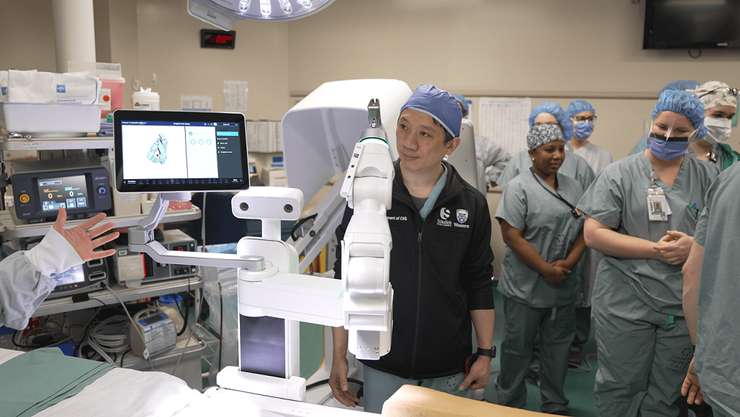A London man is living pain free for the first time in more than a year after becoming the first person in the country to receive robotic assisted spinal surgery.
Dave Meyn had been suffering from chronic back pain and sciatica in his right leg. The pain, which came on suddenly in early 2023, was so extreme that repeated visits to his family doctor, chiropractors, and massage therapists did nothing to help.
“It was very debilitating, to the point that the shooting pain in my right leg caused me to stumble and fall,” said Meyn. “It was difficult to live with and started to negatively affect my day-to-day life.”
Cue the clinical neurosciences team at London Health Sciences Centre:
Using a state-of-the-art robot designed to assist with direct lateral spinal surgery, doctors at London Health Sciences Centre (LHSC) were able to completely rid Meyn of his back issues. The MazorX Spinal Robot was acquired by the hospital through a partnership with Western University's Schulich School of Medicine and Dentistry. The post-secondary institution funded the original cost of the robot, used it for research, and then transferred it over to LHSC for clinical use.
Doctors had determined Meyn needed surgery in two spots on his spine. Traditionally, this would have required two separate trips under the knife with the patient lying on their stomach. However, with the robot the doctors performed just one surgery with Meyn on his side.
"Performing a surgery from this position can be quite challenging, but with the robot, it allows us to virtually see where the bone is within the patient's body, and then the robot maintains the trajectory we need and guides us towards the right direction,” said Dr. Victor Yang, a neurosurgeon at LHSC. “This meant we were able to perform two minimally invasive surgeries at once without having to also reposition the patient.”
In February, Meyn became the first person in Canada to undergo this robotic assisted spinal surgery.
“When I woke up from the surgery, the sciatica pain in my leg was immediately gone. It was amazing,” said Meyn. “The surgery definitely did its job.”
The clinical neurosciences team has since gone on to use the robot to perform minimally invasive surgical spinal procedures on five other patients.
"I think the use of robotic assistance will become more common for this type of procedure as it provides more consistency and, in general, better outcomes and care," said Yang.
